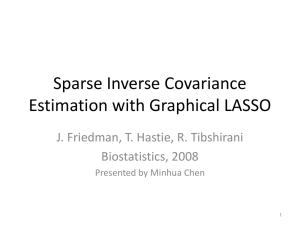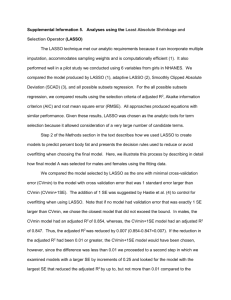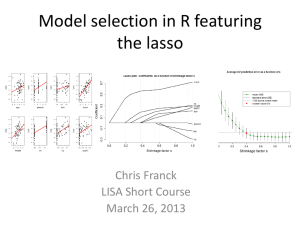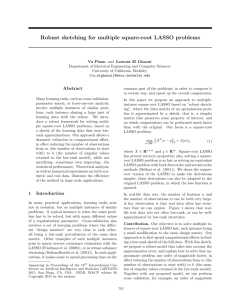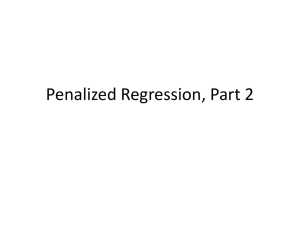Link to slides - NCSU Statistics
advertisement
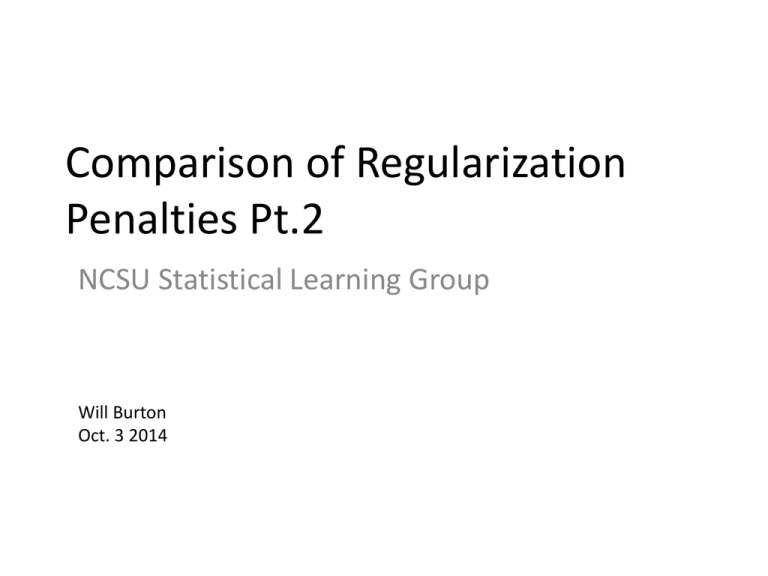
Comparison of Regularization Penalties Pt.2 NCSU Statistical Learning Group Will Burton Oct. 3 2014 Review The goal of regularization is to minimize some loss function (commonly sum of squared errors) while preventing -Overfitting (high variance, low bias) the model on the training data set. and being careful not to cause -Underfitting (low variance, high bias) Underfitting vs Overfitting High Error that comes from approximating a real life problem by a simpler model Optimal amount of bias and variance How much would the function change using a different training data set Review cont. • Regularization resolves the overfitting problem by applying a penalty to coefficients in the loss function, preventing them from too closely matching the training data set. • There are many different regularization penalties that can be applied according to the data type. Past Penalties Past Penalties Additional Penalties Grouped Lasso Motivation: In some problems, the predictors belong to pre-defined groups. In this situation it may be desirable to shrink and select the members of a group together. The grouped Lasso achieves this. ex. Birth weight predicted by the mother’s: Age, Age^2, Age^3 Weight, Weight^2, Weight^3 Grouped Lasso Minimize L (|| Y X L B 1 Where ||22 1 p ||B ||2 ) || B ||2 B12 B2 2 B32 ... Bp 2 (Euclidean Norm) L = The number of groups, p = number of predictors in each group Grouped Lasso Group Lasso uses a similar penalty to Lasso but now instead of penalizing one coefficient, it penalizes a group of coefficients 1 2 B .54 3 x1 x2 x3 x4 x5 x6 x7 1 2 4 6 10 22 5 3 9 6 5 6 4 20 25 22 3 7 40 1012 9 6 || B2 ||2 B32 B4 2 B5 2 x8 50 .2 .1 .3 .6 .7 .9 .2 Example-Group Lasso Predict birth weights based on • Mothers Age (polynomials of 1st 2nd and 3rd degree) • Mothers Weight (polynomials of 1st 2nd and 3rd degree) • Race: white or black indicator functions • Smoke: smoking status • Number of previous premature labors • History of hypertension • Presence of uterine irritability • Number of physician visits during 1st trimester Data Structure Used R package “grpreg”, model <- grpreg(X,y,groups,penalty = “grLasso”) Lasso Fit Grouped Lasso Fit Lasso Grouped Lasso Predictions Versus Actual Weights Other Penalties Adaptive Lasso Motivation: In order for Lasso to select the correct model it must assume that relevant predictors can’t be too correlated with irrelevant predictors. Lasso has a hard time determining which predictor to eliminate, and may eliminate the relevant while keeping the irrelevant predictor. Adaptive Lasso Minimize (|| Y XB || 2 2 p w j | B j | ) j 1 Where weights are functions of the coefficient Bj: w j 1/ | B j |v , B is the OLS estimate, and v>0 How it works Calculate OLS B’s Calculate wj’s B ' s ( X Y )( X X ) T T 1 wj 1/ | B j | Apply wj’s to penalty to find new B’s v Idea: 1)A high Beta from OLS gives low weight; A Low Beta gives high weight 2) Low weight = lower penalty; High weight = high penalty In appearance, Adaptive Lasso looks similar to Lasso, the only difference is now better predictors need a higher lambda to be eliminated, and poor predictors need a lower lambda to be eliminated Simulation To determine if the LASSO or Adaptive LASSO is better at finding the "true" structure of the model a Monte Carlo simulation was done. The true model was y = 3x1+1.5x2+ 0x3+ 0x4 + 2x5 + 0x6 + 0x7 + 0x8 Correlation of X’s Cor(X's) = 1.000 0.800 0.640 0.512 0.410 0.328 0.262 0.210 0.800 1.000 0.800 0.640 0.512 0.410 0.328 0.262 0.640 0.800 1.000 0.800 0.640 0.512 0.410 0.328 0.512 0.640 0.800 1.000 0.800 0.640 0.512 0.410 0.410 0.512 0.640 0.800 1.000 0.800 0.640 0.512 0.328 0.410 0.512 0.640 0.800 1.000 0.800 0.640 0.262 0.328 0.410 0.512 0.640 0.800 1.000 0.800 0.210 0.262 0.328 0.410 0.512 0.640 0.800 1.000 Auto regressive correlation structure with rho=0.8 Data was generated from this true model • X's from a multivariate normal model • Random errors were added with mean 0 and sd=3 Lasso, ADLasso, and OLS were fit. Process repeated 500 times for n=20, 100 Average and median prediction error reported along with whether or not correct structure (oracle) was selected Simulation Results n=20 OLS LASSO ADLASSO Mean PE 6.490 3.136 3.717 SE 0.218 0.150 0.151 Median PE 5.357 2.387 3.000 Oracle 0.000 0.102 0.112 Mean PE 0.760 0.534 0.539 SE 0.019 0.016 0.019 Median PE 0.683 0.446 0.426 Oracle 0.000 0.134 0.444 n=100 OLS LASSO ADLASSO Summary • Covered the basics of regularization as well as 5 different penalty choices: Lasso, Ridge, Elastic, Grouped Lasso, and Adaptive Lasso. • We have finished the regularization section and Neal will take over next October 17th with an overview of classification

